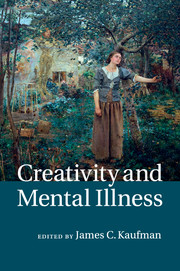Book contents
- Frontmatter
- Dedication
- Contents
- List of figures
- List of tables
- List of contributors
- Preface
- Acknowledgments
- Part I Creativity and mental illness: the state of the field
- Part II Cognitive and neuroscientific perspectives on creativity and mental illness
- 5 Neurocognitive mechanisms underlying creative thinking: indications from studies of mental illness
- 6 The evolutionary genetics of the creativity–psychosis connection
- 7 Non-linearity in creativity and mental illness: the mixed blessings of chaos, catastrophe, and noise in brain and behavior
- 8 Artists’ vulnerability to psychopathology: an integrative cognitive perspective
- Part III Creativity and the spectrum of mental illness
- Part IV Creativity and mental illness: possible commonalities
- Part V Creativity and mental health
- Part VI Creativity and mental illness: what now?
- Index
- References
8 - Artists’ vulnerability to psychopathology: an integrative cognitive perspective
from Part II - Cognitive and neuroscientific perspectives on creativity and mental illness
Published online by Cambridge University Press: 05 August 2014
- Frontmatter
- Dedication
- Contents
- List of figures
- List of tables
- List of contributors
- Preface
- Acknowledgments
- Part I Creativity and mental illness: the state of the field
- Part II Cognitive and neuroscientific perspectives on creativity and mental illness
- 5 Neurocognitive mechanisms underlying creative thinking: indications from studies of mental illness
- 6 The evolutionary genetics of the creativity–psychosis connection
- 7 Non-linearity in creativity and mental illness: the mixed blessings of chaos, catastrophe, and noise in brain and behavior
- 8 Artists’ vulnerability to psychopathology: an integrative cognitive perspective
- Part III Creativity and the spectrum of mental illness
- Part IV Creativity and mental illness: possible commonalities
- Part V Creativity and mental health
- Part VI Creativity and mental illness: what now?
- Index
- References
Summary
Introduction
Many highly creative individuals have been noted to experience mental health problems. Since the 1960s, the cognitive-behavioral therapy (CBT) model has become pivotal in the understanding and treatment of psychological difficulties. However, it is rarely considered by creativity researchers who more usually focus upon psychoanalytic, personality, contextual, or biological factors. This chapter explores commonalities between the cognitive styles observed in both the creative and those who are psychologically vulnerable. In doing so, it offers new insights into the relationship between creativity and some forms of psychopathology. I begin by introducing CBT, before investigating similarities between the cognitive styles that are (a) considered to underlie mental health difficulties – which are more common in the highly creative – and (b) implicated in the creative process. The chapter ends by examining two strands of research that investigate whether these similarities exist within creative samples.
CBT has arguably become the foremost psychological treatment for many of those suffering with mental health difficulties. The approach has revolutionized mental health care. By way of illustration, the UK’s National Institute of Health and Care Excellence (NICE) has determined, by systematically reviewing the evidence base, that it should be a core component of treatment for those suffering from one of many disorders. These include depression (2009), panic disorder and generalized anxiety disorder (2007), posttraumatic stress disorder (2005a), obsessive–compulsive/body dysmorphic disorder (2005b), and also schizophrenia (2002). Consequently, as part of the largest scheme of its type to date, the government is committed to train and employ a further 3,600 new CBT therapists to practice within the English National Health Service in an attempt to improve access to psychological therapy in England (Clark et al., 2009).
- Type
- Chapter
- Information
- Creativity and Mental Illness , pp. 145 - 166Publisher: Cambridge University PressPrint publication year: 2014



